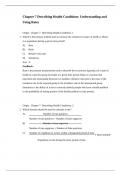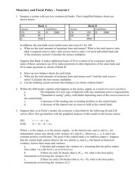Chapter 7 Describing Health Conditions: Understanding and
Using Rates
Origin: Chapter 7- Describing Health Conditions, 1
1. Which is the primary method used to measure the existence of states of health or illness
in a population during a given time period?
A) Rate
B) Ratio
C) Relative risk ratio
D) Sensitivity
Ans: A
Feedback:
Rate is the primary measurement used to describe the occurrence (quantity) of a state of
health in a specific group of people in a given time period. Ratio is a fraction that
represents the relationship between two numbers. Relative risk ratio is the ratio of the
incidence rate in the exposed group to the incidence rate in the nonexposed group.
Sensitivity is the ability of a test to correctly identify people who have a health problem
or the probability of testing positive if the health problem is truly present.
Origin: Chapter 7- Describing Health Conditions, 2
2. Which formula should be used to calculate a rate?
A) Number of true positives
Number of true positives + Number of false negatives
B) Number of true negatives
Number of true negatives + Number of false positives
C) Number of conditions or events within a designated period of time
× Base multiple
Population at risk during the same period of time
,D) Number of deaths from a specific disease
×100
Number of cases of the same disease
Ans: C
Feedback:
Below are the equations for various measures.
Number of conditions or events within a designated period of time
Rate = × Base multipl
Population at risk during the same period of time
Number of true positives
Sensitivity =
Number of true positives + Number of false negatives
Number of true negatives
Specificity =
Number of true negatives + Number of false positives
Number of deaths from a specific disease
Case fatality rate = ×100
Number of cases of the same disease
, Origin: Chapter 7- Describing Health Conditions, 3
3. Which formula should be used to calculate the infant mortality rate?
A) Number of deaths of children <1 year of age in one year
×1,000
Number of live births in the same year
B) Number of fetal deaths plus infant deaths <7 days of age in one year
×1,000
Number of live births plus fetal deaths in the same year
C) Number of deaths of children <28 days of age in one year
×1,000
Number of live births in the same year
D) Number of fetal deaths in one year
×1,000
Number of live births plus fetal deaths in the same year
Ans: A
Feedback:
Below are the equations for various measures.
Number of deaths of children <1 year of age in one year
Infant mortality rate = ×1,000
Number of live births in the same year
Perinatal mortality rate =
Number of fetal deaths plus infant deaths <7 days of age in one year
×1,000
Number of live births plus fetal deaths in the same year
Neonatal mortality rate =
Number of deaths of children <28 days of age in one year
×1,000
Number of live births in the same year
Number of fetal deaths in one year
Fetal mortality rate = ×1,000
Number of live births plus fetal deaths in the same year
Using Rates
Origin: Chapter 7- Describing Health Conditions, 1
1. Which is the primary method used to measure the existence of states of health or illness
in a population during a given time period?
A) Rate
B) Ratio
C) Relative risk ratio
D) Sensitivity
Ans: A
Feedback:
Rate is the primary measurement used to describe the occurrence (quantity) of a state of
health in a specific group of people in a given time period. Ratio is a fraction that
represents the relationship between two numbers. Relative risk ratio is the ratio of the
incidence rate in the exposed group to the incidence rate in the nonexposed group.
Sensitivity is the ability of a test to correctly identify people who have a health problem
or the probability of testing positive if the health problem is truly present.
Origin: Chapter 7- Describing Health Conditions, 2
2. Which formula should be used to calculate a rate?
A) Number of true positives
Number of true positives + Number of false negatives
B) Number of true negatives
Number of true negatives + Number of false positives
C) Number of conditions or events within a designated period of time
× Base multiple
Population at risk during the same period of time
,D) Number of deaths from a specific disease
×100
Number of cases of the same disease
Ans: C
Feedback:
Below are the equations for various measures.
Number of conditions or events within a designated period of time
Rate = × Base multipl
Population at risk during the same period of time
Number of true positives
Sensitivity =
Number of true positives + Number of false negatives
Number of true negatives
Specificity =
Number of true negatives + Number of false positives
Number of deaths from a specific disease
Case fatality rate = ×100
Number of cases of the same disease
, Origin: Chapter 7- Describing Health Conditions, 3
3. Which formula should be used to calculate the infant mortality rate?
A) Number of deaths of children <1 year of age in one year
×1,000
Number of live births in the same year
B) Number of fetal deaths plus infant deaths <7 days of age in one year
×1,000
Number of live births plus fetal deaths in the same year
C) Number of deaths of children <28 days of age in one year
×1,000
Number of live births in the same year
D) Number of fetal deaths in one year
×1,000
Number of live births plus fetal deaths in the same year
Ans: A
Feedback:
Below are the equations for various measures.
Number of deaths of children <1 year of age in one year
Infant mortality rate = ×1,000
Number of live births in the same year
Perinatal mortality rate =
Number of fetal deaths plus infant deaths <7 days of age in one year
×1,000
Number of live births plus fetal deaths in the same year
Neonatal mortality rate =
Number of deaths of children <28 days of age in one year
×1,000
Number of live births in the same year
Number of fetal deaths in one year
Fetal mortality rate = ×1,000
Number of live births plus fetal deaths in the same year



